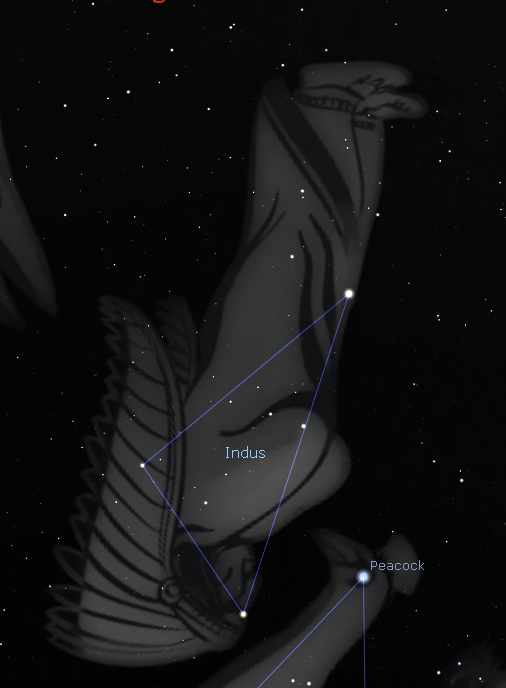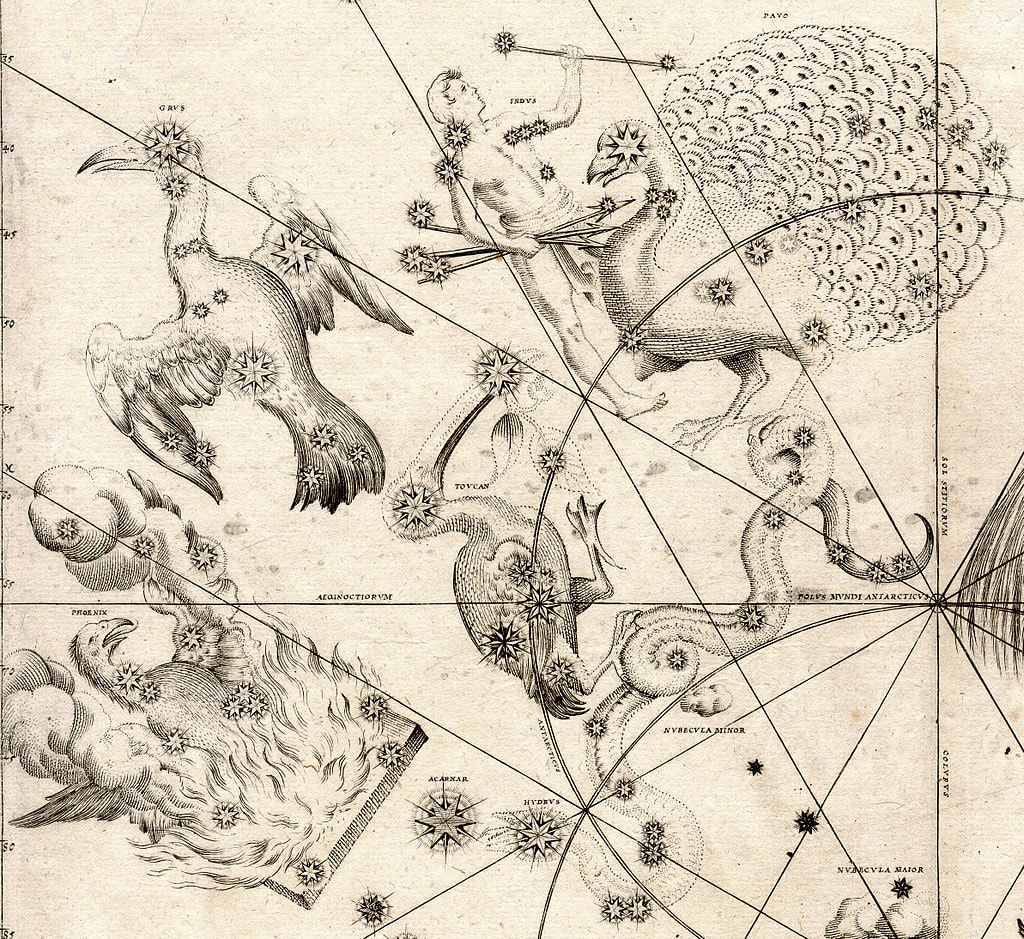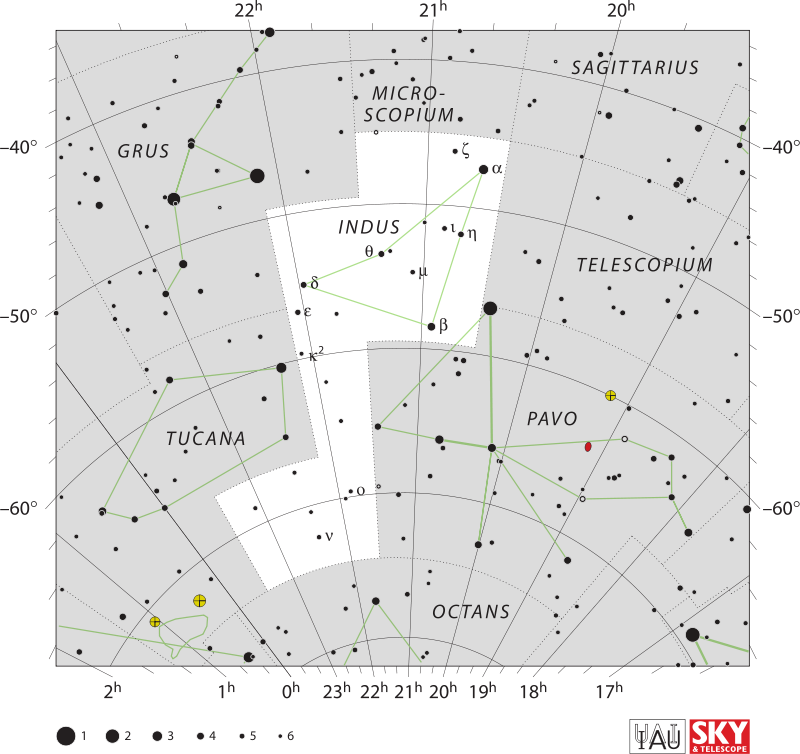|
The southern constellation Indus was first observed by European astronomers in the 1590s, and by early 1598, Petrus Plancius had mapped it on a globe. In 1603, Bayer's sky atlas Uranometria featured it on a plate displaying southern constellations. Although it is located much south of the Tropic of Capricorn, the Equator can see its triangular shape for most of the year. It has complicated boundaries and is long from north to south. Although it is uncertain which Indigenous people the constellation was originally intended to symbolise, the English translation of its name is typically given as the Indian.
The top one hundred brightest stars as seen from the solar system are absent from Indus (apparent magnitude). Three of its stars are fourth magnitude, while two of its stars are third magnitude. |
Its brightest star, Alpha Indi, is a magnitude 3.1 orange giant located 101 light-years away. Beta Indi is a magnitude 3.7 orange giant six hundred light-years away. 185 light-years away from Earth, Delta Indi is a white star with a magnitude of 4.4. With Beta in the southeast and the right angle being formed by the three, the triangle is almost perfectly right-angled.
One of the stars closest to Earth is Epsilon Indi, which is only 11.8 light years distant. The yellow dwarf Sun is slightly hotter and larger than this orange dwarf, which has a magnitude of 4.7. (Ridpath & Tirion 2001) The system has long been a top contender in SETI research because it was found to have a pair of binary brown dwarfs. (Lawton 1975) Behind 61 Cygni and Groombridge 1830, this star has the third-highest proper motion of all those that can be seen without a telescope, making it the ninth-highest overall. Around 2640, this will cause the star to shift into Tucana. Alpha and Beta, it occupies the same space.
One brilliant binary star can be seen in Indus. 97 light-years away from Earth, Theta Indi is a binary star that can be seen in tiny amateur telescopes. A white star of magnitude 4.5 is its primary star, while a white star of magnitude 7.0 is its secondary star. (Ridpath & Tirion 2001) It appears close to the hypotenuse of the right-angled triangle formed by the three brightest stars in the Indus constellation, Alpha, Beta, and Delta.
The only variable star in Indus that is bright is T Indi. It is a 1900 light-year-distance, semi-regular, intensely coloured red giant with a period of 11 months. Its minimum and maximum magnitudes are 7 and 5, respectively. (Ridpath & Tirion 2001) NGC 7090 and NGC 7049 are examples of galaxies.
A super luminous supernova known as ASASSN-15lh was discovered by the All-Sky Automated Survey for SuperNovae (ASAS-SN) in 2015. (Also designated SN 2015L). According to research done by Subo Dong and his team at the Kavli Institute for Astronomy and Astrophysics (KIAA) at Peking University, the galaxy was roughly twice as bright as any supernova that was discovered and, at its brightest, was nearly fifty times more intrinsically bright than the Milky Way. Its distance, 3.82 gigalight-years, indicates that it is about half as old as the universe.
One of the stars closest to Earth is Epsilon Indi, which is only 11.8 light years distant. The yellow dwarf Sun is slightly hotter and larger than this orange dwarf, which has a magnitude of 4.7. (Ridpath & Tirion 2001) The system has long been a top contender in SETI research because it was found to have a pair of binary brown dwarfs. (Lawton 1975) Behind 61 Cygni and Groombridge 1830, this star has the third-highest proper motion of all those that can be seen without a telescope, making it the ninth-highest overall. Around 2640, this will cause the star to shift into Tucana. Alpha and Beta, it occupies the same space.
One brilliant binary star can be seen in Indus. 97 light-years away from Earth, Theta Indi is a binary star that can be seen in tiny amateur telescopes. A white star of magnitude 4.5 is its primary star, while a white star of magnitude 7.0 is its secondary star. (Ridpath & Tirion 2001) It appears close to the hypotenuse of the right-angled triangle formed by the three brightest stars in the Indus constellation, Alpha, Beta, and Delta.
The only variable star in Indus that is bright is T Indi. It is a 1900 light-year-distance, semi-regular, intensely coloured red giant with a period of 11 months. Its minimum and maximum magnitudes are 7 and 5, respectively. (Ridpath & Tirion 2001) NGC 7090 and NGC 7049 are examples of galaxies.
A super luminous supernova known as ASASSN-15lh was discovered by the All-Sky Automated Survey for SuperNovae (ASAS-SN) in 2015. (Also designated SN 2015L). According to research done by Subo Dong and his team at the Kavli Institute for Astronomy and Astrophysics (KIAA) at Peking University, the galaxy was roughly twice as bright as any supernova that was discovered and, at its brightest, was nearly fifty times more intrinsically bright than the Milky Way. Its distance, 3.82 gigalight-years, indicates that it is about half as old as the universe.
|
History
The constellation was established by Petrus Plancius using observations made by Pieter Dirkszoon Keyser and Frederick de Houtman to construct a sizable celestial globe. (Ridpath & Tirion 2001) In Johann Bayer's Uranometria from 1603 came the first representation of this constellation in a celestial atlas. (Sawyer Hogg 1951) According to Plancius, the figure was a naked man holding three arrows in one hand and one in the other. The figure was a local without a quiver or bow. (Allen 1963) It is one of the twelve constellations that Keyser and de Houtman initially identified in 1598 and which were first depicted on a celestial globe. |
Deep-sky Objects - or lack off
Indus is a relatively bland constellation. The constellation is filled with galaxies which require a large aperture telescope to get any kind of detail. Wide Aperture scopes will have these galaxies at no more than pinpoints in the picture.
Main stars - 3
Bayer stars - 16
Stars with planets - 3
Stars brighter than magnitude 3.00 - 0
Stars within 32 Ly - 1
Bordering
constellations
Indus is a relatively bland constellation. The constellation is filled with galaxies which require a large aperture telescope to get any kind of detail. Wide Aperture scopes will have these galaxies at no more than pinpoints in the picture.
Main stars - 3
Bayer stars - 16
Stars with planets - 3
Stars brighter than magnitude 3.00 - 0
Stars within 32 Ly - 1
Bordering
constellations
- Microscopium
- Sagittarius
- Telescopium
- Pavo
- Octans
- Tucana
- Grus


